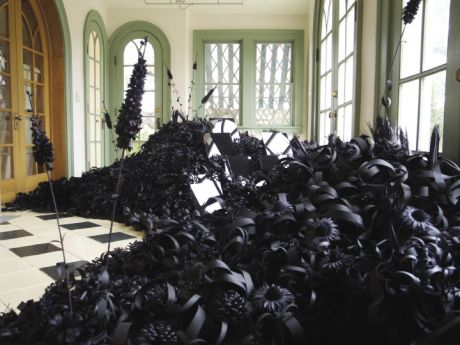In Victorian England, dexterous ladies of a certain class would carefully cut, curl, and glue thin strips of light-colored paper into flowers and ornamental shapes to adorn objects like book covers and picture frames. In her studio in Portland, ME, artist Lauren Fensterstock, 38, uses the same crafty technique, called “quilling,” to carefully curl strips of black paper into pieces of a garden. In her large-scale installations, black paper flowers and blades of grass sprout from mounds of charcoal, and black leaves wind around mirrors. Her latest collection of work, presented as a solo show at the JM Kohler Art Center in Wisconsin, features an “American lawn,” a “European garden,” and a perfect square of Japanese kiku chrysanthemums, all one dark color. It’s a wild extension of the dainty Victorian tradition, made in the same delicate way.

Quilling is a skill the Parsons grad picked up from the mother of her partner, artist Aaron Stephan. “I thought I would do this until I figured out what was next,” she says. “Then I spent six months on my first quilling piece and realized: this is what I’m doing next.”

The natural imagery in decorative arts traditions lead Fensterstock to gardens, and eventually to her installations. “As I read about the history of gardens,” she says, “I started thinking in terms of whole spaces. My work has been guided by how things grow.” Outside her studio, she keeps a real garden, and has been known to “twist ivy to make it look more ‘natural.’” In much of her installation work, she sees a similar “tension between nature running wild and something being cultivated,” partly because she’s so meticulously creating something intended to look like it has “grown out of control.”

Fensterstock often spends eight hours a day quilling, a feat of patience that connects her to ladies of the past. As for her interest in Victorian culture, however, she jokes that she is not really into that era, she’s just into the same things Victorians liked, including the color black, which she uses for its ability to “slip in and out of view.” When you see one of her installations, “it can look like this big black hole, and then it dissolves into thousands of tiny little plants. Black has this kind of magic.”
By Phoebe Magee

This review appears in the Aug/Sept 2013 issue of BUST Magazine with Janelle Monáe. Subscribe now.
Images courtesy Lauren Fensterstock


